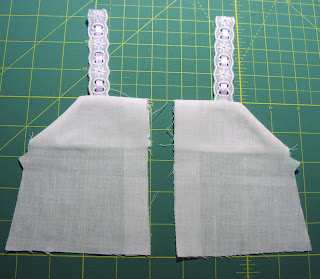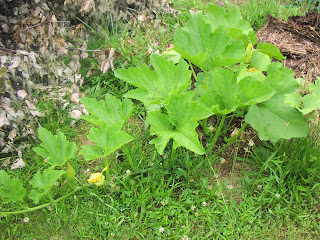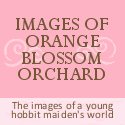Lesson 3 - Part 2
Cutting Fabric & Sewing Camisole
 NOTE TO TEACHER
NOTE TO TEACHERAs you teach your student, continue to remind her of the importance of accurate measurements when pinning a pattern on the straight of the fabric and the importance of cutting accurately, as well as the importance of finishing her seam edges TO PREVENT FRAYING. Remind her to backstitch at the beginning and end of all seams. Refer to Lesson 2 - STEP 4.
Allow the student to take more than one session to sew her project. It doesn't need to be finished in one marathon session. If she becomes frustrated at a certain step, tell her to set it aside, and that you will work on it with her again later. Remember, we are not only teaching her HOW to sew, but also to ENJOY sewing.
Rather than show a technique that we have covered in a past lesson, I will simply refer you back to previous lessons and the STEP # that covers the particular technique.
SUPPLIES
Camisole Pattern made from Lesson 3 - Part 1
Fat-Quarter of lightweight cotton fabric
Thread that matches fabric
Small piece of lightweight, fusible interfacing
24" of 1" wide flat eyelet lace
18" inches of ribbon
(2) Size/No. 1 snaps
Straight pins
Ruler
Scissors
Needle
EXPLANATION OF LACE AND RIBBON
 Your student will be cutting two 4" lengths of ribbon for the straps of the camisole. The type and width of the ribbon is a matter of personal preference. The photo above shows some suggestions. Looking at the ribbon from the top right of photo to bottom left, the first ribbon is 3/8" wide (used alone it would be appropriate for a spaghetti strap). Next is a cotton beading eyelet which is approximately 1/2" wide. Next we have a 1/4" wide satin ribbon that would make a thin strap. Last is a 3/4" wide satin ribbon that would make a wide strap. Personally, I would stay in the 3/8" to 3/4" width range. The color of the ribbon could match or contrast with the fabric you have chosen, and you could use grosgrain ribbon, cotton ribbon, or satin. The choice is yours.
Your student will be cutting two 4" lengths of ribbon for the straps of the camisole. The type and width of the ribbon is a matter of personal preference. The photo above shows some suggestions. Looking at the ribbon from the top right of photo to bottom left, the first ribbon is 3/8" wide (used alone it would be appropriate for a spaghetti strap). Next is a cotton beading eyelet which is approximately 1/2" wide. Next we have a 1/4" wide satin ribbon that would make a thin strap. Last is a 3/4" wide satin ribbon that would make a wide strap. Personally, I would stay in the 3/8" to 3/4" width range. The color of the ribbon could match or contrast with the fabric you have chosen, and you could use grosgrain ribbon, cotton ribbon, or satin. The choice is yours. The above photo shows the eyelet lace (top of photo) which I have chosen for the hem of my doll's camisole. The ribbon and beading eyelet will be used in combination for the straps.
The above photo shows the eyelet lace (top of photo) which I have chosen for the hem of my doll's camisole. The ribbon and beading eyelet will be used in combination for the straps. I simply wove my ribbon through the beading eyelet to prepare it for the straps.
I simply wove my ribbon through the beading eyelet to prepare it for the straps.STEP 1: Pin camisole pattern to fabric. Refer to Lesson 1 (STEP 1) for placing pattern on straight of fabric.
INTERFACING
Here your student comes to a new technique. She is going to fuse interfacing to the edge of the back of the camisole. Explain to your student that Interfacing helps to strengthen or reinforce an area that might have extra strain from use of fasteners (such as buttons or snaps, etc.) It also helps to maintain a nice crisp edge when used at a garment's edge.
STEP 3: Cut 2 (3/4" X 5-1/4") strips of interfacing.
 STEP 4: Following the manufacturer's instructions, fuse the interfacing to the edge of the camisole back as shown in the above photo.
STEP 4: Following the manufacturer's instructions, fuse the interfacing to the edge of the camisole back as shown in the above photo.SEAM ALLOWANCE
All Seam allowances for this project are 1/4" unless stated otherwise.
FACINGS
Explain to your student that a facing is a method used to give a "finished" edge to a garment. There are other methods to finish the edge of a garment, but this method is quite common with the manufacturers of sewing patterns.
 STEP 5: Finish the long edge of the front and back facing using one of the following to methods:
STEP 5: Finish the long edge of the front and back facing using one of the following to methods:METHOD 2: Draw a line 1/2" from long edge of facing. Fold edge to meet line and press with iron as shown in above photo. Stitch in place with narrow zigzag stitch.
 STEP 6: With right sides of fabric facing each other, pin the edges of the camisole and facing as show in the above photo. Stitch seam (as indicated by blue line in above photo) and finish raw seam edges. Refer to Lesson 2 - STEP 6. Repeat for other half of back camisole.
STEP 6: With right sides of fabric facing each other, pin the edges of the camisole and facing as show in the above photo. Stitch seam (as indicated by blue line in above photo) and finish raw seam edges. Refer to Lesson 2 - STEP 6. Repeat for other half of back camisole. STEP 7: Cut 2 lengths of ribbon for straps. Each shoud be 4" long.
STEP 7: Cut 2 lengths of ribbon for straps. Each shoud be 4" long.
STEP 8: Align edge of ribbon (strap) with top edge of camisole, butt side of ribbon (strap) against seam indicated by blue line in above photo. The (ribbon) strap is sandwiched between the facing and the camisole back. The right side of the ribbon (strap) faces the right side of the camisole back fabric. Stitch across top as indicated by the purple line in the above photo and (as always) finish the raw seam edge.
 STEP 9: Turn pieces to right side out and press with iron. The student should have two backs of the camisole that look like the above photo.
STEP 9: Turn pieces to right side out and press with iron. The student should have two backs of the camisole that look like the above photo.
REPEAT STEPS 6 - 9 FOR FOR CAMISOLE FRONT & FACING.
 The student's camisole should now look like the above photo.
The student's camisole should now look like the above photo.STEP 10: Explain to your student that NOTCHES are used by pattern makers for several purposes. One purpose is to indicate edges that go together; a second purpose is to properly align the edges of a garment. With right sides of fabric together, match the notch on the back of camisole with the notch on the front and pin the front and back together at that point. Then match the top edge together and pin at that point. Last, match and pin the bottom of the side edge. Repeat pinning procedure on other side of garment.
 STEP 11: Sew both side seams as indicated by blue line in above photo. Finish raw seam edge. Press seams toward back of garment.
STEP 11: Sew both side seams as indicated by blue line in above photo. Finish raw seam edge. Press seams toward back of garment.  STEP 12: Fold remaining ribbon in half and mark center. Stitch securely to cener front of camisole. Tie a bow. Cut ends of ribbon diagonally.
STEP 12: Fold remaining ribbon in half and mark center. Stitch securely to cener front of camisole. Tie a bow. Cut ends of ribbon diagonally.
STEP 14: Trim eyelet lace even with back edge of camisole.
 STEP 15: Use Method 1 to finish both back edges of camisole. (See STEP 1 above).
STEP 15: Use Method 1 to finish both back edges of camisole. (See STEP 1 above).
Note: You will notice from the photo above that serging edges of the camisole to prevent fraying may be used instead of Method 1.
STEP 16: Fold both interfaced back edges of camisole to inside of garment using the edge of the interfacing as a guide. Press with iron.
STEP 17: SNAP PLACEMENT should be marked 1/4" from top edge on the INSIDE of the camisole as indicated in above photo. Mark a second dot 2" below first dot. Repeat on second side of back on the OUTSIDE of the garment.
NOTE: You may think that a SIZE/NO. 1 snap is too large. I recommend this size for students because the larger size enables young hands to hold them in place more eaisily while sewing them to the garment. It is also easier to see if the students stitches are even and neat. Later when they are more adept at sewing on snaps, they can begin to use smaller sized snaps when appropriate to the garment.
STEP 18: SEWING SNAPS is done in the following manner: place center of snap directly over dot. Using a double strand of thread in needle, sew through hole in snap three times before moving to the next hole. Refer to above photo. After completing all four snap holes, tie a neat knot and cut thread. Repeat with other snaps.
Congratulations! You have now completed a camisole that your 18" doll can wear with the skirts you created in Lessons 1 & 2.






















































